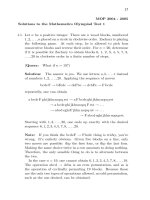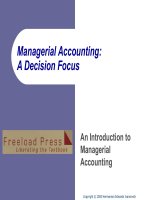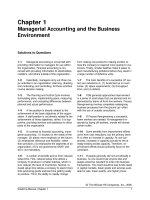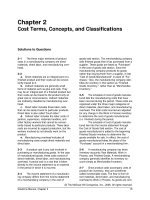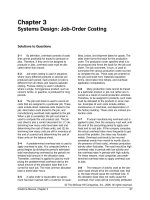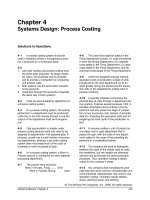Solutions to question managerial accounting ch09 profit planning
Bạn đang xem bản rút gọn của tài liệu. Xem và tải ngay bản đầy đủ của tài liệu tại đây (173.26 KB, 53 trang )
Chapter 9
Profit Planning
Solutions to Questions
9-1
A budget is a detailed plan outlining the
acquisition and use of financial and other resources over a given time period. As such, it
represents a plan for the future expressed in
formal quantitative terms. Budgetary control
involves the use of budgets to control the actual
activities of a firm.
9-2
1. Budgets provide a means of communicating management’s plans throughout the organization.
2. Budgets force managers to think about
and plan for the future.
3. The budgeting process provides a means
of allocating resources to those parts of the organization where they can be used most effectively.
4. The budgeting process can uncover potential bottlenecks before they occur.
5. Budgets coordinate the activities of the
entire organization. Budgeting helps to ensure
that everyone in the organization is pulling in
the same direction.
6. Budgets define goals and objectives that
can serve as benchmarks for evaluating subsequent performance.
9-3
Responsibility accounting is a system in
which a manager is held responsible for those
items of revenues and costs—and only those
items—that the manager can control to a significant extent. Each line item in the budget is
made the responsibility of a manager who is
then held responsible for differences between
budgeted and actual results.
9-4
A master budget represents a summary
of all of management’s plans and goals for the
future, and outlines the way in which these
plans are to be accomplished. The master
budget is composed of a number of smaller,
specific budgets encompassing sales, production, raw materials, direct labor, manufacturing
overhead, selling and administrative expenses,
and inventories. The master budget generally
also contains a budgeted income statement,
budgeted balance sheet, and cash budget.
9-5
The level of sales impacts virtually every
other aspect of the firm’s activities. It determines the production budgets, cash collections,
cash disbursements, and selling and administrative budgets that in turn determine the cash
budget and budgeted income statement and
balance sheet.
9-6
No. Planning and control are different,
although related, concepts. Planning involves
developing objectives and formulating steps to
achieve those objectives. Control, by contrast,
involves the means by which management ensures that the objectives set down at the planning stage are attained.
9-7
The flow of information moves in two
directions—upward and downward. The initial
flow should be from the bottom of the organization upward. Each person having responsibility
over revenues or costs should prepare the
budget data against which his or her subsequent
performance will be measured. As the budget
data are communicated upward, higher-level
managers should review the budgets for consistency with the overall goals of the organization
and the plans of other units in the organization.
Any issues should be resolved in discussions
between the individuals who prepared the
budgets and their managers.
All levels of an organization should participate in the budgeting process—not just top
management or the accounting department.
Generally, the lower levels will be more familiar
with detailed, day-to-day operating data, and for
© The McGraw-Hill Companies, Inc., 2006. All rights reserved.
Solutions Manual, Chapter 9
491
this reason will have primary responsibility for
developing the specifics in the budget. Top levels of management will have a better perspective concerning the company’s strategy.
9-8
A self-imposed budget is one in which
persons with responsibility over cost control
prepare their own budgets, i.e., the budget is
not imposed from above. The major advantages
are: (1) the views and judgments of persons
from all levels of an organization are represented in the final budget document; (2) budget
estimates generally are more accurate and reliable, since they are prepared by those who are
closest to the problems; (3) managers generally
are more motivated to meet budgets which they
have participated in setting; (4) self-imposed
budgets reduce the amount of upward “blaming”
resulting from inability to meet budget goals.
One caution must be exercised in the use of
self-imposed budgets. The budgets prepared by
lower-level managers should be carefully reviewed to prevent too much slack.
9-9
Budgeting can assist a firm in its employment policies by providing information on
probable future staffing needs. Budgeting can
also assist in stabilizing a company’s work force.
By careful planning through the budget process,
a company can often “smooth out” its activities
and avoid erratic hiring and laying off employees.
9-10 No, although this is clearly one of the
purposes of the cash budget. The principal purpose is to provide information on probable cash
needs during the budget period, so that bank
loans and other sources of financing can be anticipated and arranged well in advance.
9-11 Zero-based budgeting requires that
managers start at zero levels every year and
justify all costs as if all programs were being
proposed for the first time. In traditional budgeting, by contrast, budgets are usually based on
the previous year’s data.
© The McGraw-Hill Companies, Inc., 2006. All rights reserved.
492
Managerial Accounting, 11th Edition
Exercise 9-1 (20 minutes)
April
1.
May
June
Total
February sales:
$230,000 × 10%.......... $ 23,000
$ 23,000
March sales: $260,000
× 70%, 10%................ 182,000 $ 26,000
208,000
April sales: $300,000 ×
20%, 70%, 10% ..........
60,000
210,000 $ 30,000
300,000
May sales: $500,000 ×
20%, 70% ...................
100,000 350,000
450,000
June sales: $200,000 ×
40,000
40,000
20%............................
Total cash collections....... $265,000 $336,000 $420,000 $1,021,000
Observe that even though sales peak in May, cash collections peak in
June. This occurs because the bulk of the company’s customers pay in
the month following sale. The lag in collections that this creates is even
more pronounced in some companies. Indeed, it is not unusual for a
company to have the least cash available in the months when sales are
greatest.
2. Accounts receivable at June 30:
From May sales: $500,000 × 10%.......................... $ 50,000
From June sales: $200,000 × (70% + 10%) ........... 160,000
Total accounts receivable at June 30....................... $210,000
© The McGraw-Hill Companies, Inc., 2006. All rights reserved.
Solutions Manual, Chapter 9
493
Exercise 9-2 (10 minutes)
Budgeted sales in units..............
Add desired ending inventory* ...
Total needs...............................
Less beginning inventory ...........
Required production ..................
April
50,000
7,500
57,500
5,000
52,500
May
75,000
9,000
84,000
7,500
76,500
June
Quarter
90,000 215,000
8,000
8,000
98,000 223,000
9,000
5,000
89,000 218,000
*10% of the following month’s sales in units.
© The McGraw-Hill Companies, Inc., 2006. All rights reserved.
494
Managerial Accounting, 11th Edition
Exercise 9-3 (15 minutes)
First
Year 2
Second
Third
Required production in bottles ....................... 60,000 90,000
Number of grams per bottle ..........................
× 3
× 3
Total production needs—grams...................... 180,000 270,000
First
Production needs—grams (above) ................. 180,000
Add desired ending inventory—grams ............ 54,000
Total needs—grams ...................................... 234,000
Less beginning inventory—grams................... 36,000
Raw materials to be purchased— grams......... 198,000
Cost of raw materials to be purchased at 150
roubles per kilogram .................................. 29,700
Second
Fourth
150,000 100,000
× 3
× 3
450,000 300,000
Year 2
Third
270,000
90,000
360,000
54,000
306,000
450,000
60,000
510,000
90,000
420,000
45,900
63,000
Fourth
Year 3
First
70,000
× 3
210,000
Year
300,000 1,200,000
42,000
42,000
342,000 1,242,000
60,000
36,000
282,000 1,206,000
42,300
180,900
© The McGraw-Hill Companies, Inc., 2006. All rights reserved.
Solutions Manual, Chapter 9
495
Exercise 9-4 (20 minutes)
1. Assuming that the direct labor workforce is adjusted each quarter, the direct labor budget would be:
1st
Quarter
2nd
Quarter
3rd
Quarter
4th
Quarter
Year
Units to be produced.......................................
8,000
6,500
7,000
7,500
29,000
Direct labor time per unit (hours) .....................
× 0.35
× 0.35
× 0.35
× 0.35
× 0.35
Total direct labor-hours needed .......................
2,800
2,275
2,450
2,625
10,150
Direct labor cost per hour ................................ × $12.00 × $12.00 × $12.00 × $12.00 × $12.00
Total direct labor cost...................................... $ 33,600 $ 27,300 $ 29,400 $ 31,500 $121,800
2. Assuming that the direct labor workforce is not adjusted each quarter and that overtime wages are
paid, the direct labor budget would be:
Units to be produced.......................................
Direct labor time per unit (hours) .....................
Total direct labor-hours needed .......................
Regular hours paid..........................................
Overtime hours paid .......................................
1st
Quarter
8,000
× 0.35
2,800
2,600
200
Wages for regular hours (@ $12.00 per hour) ... $31,200
Overtime wages (@ $12.00 per hour × 1.5)......
3,600
Total direct labor cost ..................................... $34,800
2nd
Quarter
6,500
× 0.35
2,275
2,600
-
3rd
Quarter
7,000
× 0.35
2,450
2,600
-
4th
Quarter
7,500
× 0.35
2,625
2,600
25
Year
29,000
× 0.35
10,150
10,400
225
$31,200 $31,200 $31,200 $124,800
450
4,050
$31,200 $31,200 $31,650 $128,850
© The McGraw-Hill Companies, Inc., 2006. All rights reserved.
496
Managerial Accounting, 11th Edition
Exercise 9-5 (15 minutes)
1.
Yuvwell Corporation
Manufacturing Overhead Budget
Budgeted direct labor-hours..................................
Variable overhead rate .........................................
Variable manufacturing overhead ..........................
Fixed manufacturing overhead ..............................
Total manufacturing overhead ..............................
Less depreciation .................................................
Cash disbursements for manufacturing overhead....
1st
2nd
3rd
4th
Quarter Quarter Quarter Quarter
Year
8,000
8,200
8,500
7,800
32,500
× $3.25 × $3.25 × $3.25 × $3.25 × $3.25
$26,000 $26,650 $27,625 $25,350 $105,625
48,000 48,000 48,000 48,000 192,000
74,000 74,650 75,625 73,350 297,625
16,000 16,000 16,000 16,000
64,000
$58,000 $58,650 $59,625 $57,350 $233,625
2. Total budgeted manufacturing overhead for the year (a) ...
Total budgeted direct labor-hours for the year (b) .............
Manufacturing overhead rate for the year (a) ÷ (b) ...........
$297,625
32,500
$
9.16
© The McGraw-Hill Companies, Inc., 2006. All rights reserved.
Solutions Manual, Chapter 9
497
Exercise 9-6 (15 minutes)
Weller Company
Selling and Administrative Expense Budget
Budgeted unit sales ............................................
Variable selling and administrative expense per
unit.................................................................
Variable expense ................................................
Fixed selling and administrative expenses:
Advertising ......................................................
Executive salaries ............................................
Insurance........................................................
Property taxes .................................................
Depreciation ....................................................
Total fixed expense ............................................
Total selling and administrative expenses .............
Less depreciation................................................
Cash disbursements for selling and administrative expenses ..................................................
1st
Quarter
15,000
2nd
Quarter
16,000
3rd
Quarter
14,000
4th
Quarter
13,000
Year
58,000
× $2.50 × $2.50 × $2.50 × $2.50 × $2.50
$ 37,500 $ 40,000 $ 35,000 $ 32,500 $145,000
8,000
35,000
5,000
20,000
68,000
105,500
20,000
8,000
35,000
8,000
35,000
5,000
8,000
20,000 20,000
71,000 68,000
111,000 103,000
20,000 20,000
8,000
35,000
20,000
63,000
95,500
20,000
32,000
140,000
10,000
8,000
80,000
270,000
415,000
80,000
$ 85,500 $ 91,000 $ 83,000 $ 75,500 $335,000
© The McGraw-Hill Companies, Inc., 2006. All rights reserved.
498
Managerial Accounting, 11th Edition
Exercise 9-7 (20 minutes)
Quarter (000 omitted)
1
2
3
Cash balance, beginning ............................... $ 6 *
Add collections from customers ..................... 65
Total cash available ...................................... 71 *
Less disbursements:
Purchase of inventory................................. 35 *
Operating expenses ................................... 28
Equipment purchases .................................
8 *
Dividends ..................................................
2*
Total disbursements...................................... 73
Excess (deficiency) of cash available over
disbursements ........................................... (2)*
Financing:
Borrowings................................................
7
Repayments (including interest) .................. —
Total financing .............................................
7
Cash balance, ending.................................... $ 5
$ 5
70
75
45
30
8
2
85
$
4
5
$ 5
96 *
92
101
97
*
*
*
*
*
(10)
15 *
—
15
$ 5
48
30 *
10 *
2 *
90
35 *
25
10
2 *
72
11 *
25
—
(6)
(6)
$ 5
Year
$ 6
323 *
329
163
113 *
36 *
8
320
9
—
22
(17)* (23)
(17)
(1)
$ 8
$ 8
*Given.
© The McGraw-Hill Companies, Inc., 2006. All rights reserved.
Solutions Manual, Chapter 9
499
Problem 9-8 (30 minutes)
1. The budget at Springfield is an imposed “top-down” budget that fails to
consider both the need for realistic data and the human interaction essential to an effective budgeting/control process. The President has not
given any basis for his goals, so one cannot know whether they are realistic for the company. True participation of company employees in
preparation of the budget is minimal and limited to mechanical gathering and manipulation of data. This suggests there will be little enthusiasm for implementing the budget.
The sales by product line should be based on an accurate sales forecast
of the potential market. Therefore, the sales by product line should have
been developed first to derive the sales target rather than the reverse.
The initial meeting between the Vice President of Finance, Executive
Vice President, Marketing Manager, and Production Manager should be
held earlier. This meeting is held too late in the budget process.
2. Springfield should consider adopting a “bottom-up” budget process. This
means that the people responsible for performance under the budget
would participate in the decisions by which the budget is established. In
addition, this approach requires initial and continuing involvement of
sales, financial, and production personnel to define sales and profit
goals that are realistic within the constraints under which the company
operates. Although time consuming, the approach should produce a
more acceptable, honest, and workable goal-control mechanism.
The sales forecast should be developed considering internal salesforecasts as well as external factors. Costs within departments should be
divided into fixed and variable, controllable and noncontrollable, discretionary and nondiscretionary. Flexible budgeting techniques could then
allow departments to identify costs that can be modified in the planning
process.
© The McGraw-Hill Companies, Inc., 2006. All rights reserved.
500
Managerial Accounting, 11th Edition
Problem 9-8 (continued)
3. The functional areas should not necessarily be expected to cut costs
when sales volume falls below budget. The time frame of the budget
(one year) is short enough so that many costs are relatively fixed. For
costs that are fixed, there is little hope for a reduction as a consequence
of short-run changes in volume. However, the functional areas should be
expected to cut costs should sales volume fall below target when:
a. control is exercised over the costs within their function.
b. budgeted costs were more than adequate for the originally targeted
sales, i.e., slack was present.
c. budgeted costs vary to some extent with changes in sales.
d. there are discretionary costs that can be delayed or omitted with no
serious effect on the department.
(Adapted unofficial CMA Solution)
© The McGraw-Hill Companies, Inc., 2006. All rights reserved.
Solutions Manual, Chapter 9
501
Problem 9-9 (45 minutes)
1. Schedule of expected cash collections:
July
Month
August September
From accounts receivable:
May sales
$250,000 × 3% .......... $ 7,500
June sales
$300,000 × 70% ........ 210,000
$300,000 × 3% ..........
$ 9,000
From budgeted sales:
July sales
$400,000 × 25% ........ 100,000
$400,000 × 70% ........
280,000
$400,000 × 3% ..........
$ 12,000
August sales
$600,000 × 25% ........
150,000
$600,000 × 70% ........
420,000
September sales
$320,000 × 25% ........
80,000
Total cash collections........ $317,500 $439,000 $512,000
Quarter
$
7,500
210,000
9,000
100,000
280,000
12,000
150,000
420,000
80,000
$1,268,500
© The McGraw-Hill Companies, Inc., 2006. All rights reserved.
502
Managerial Accounting, 11th Edition
Problem 9-9 (continued)
2. Cash budget:
Month
July
Cash balance, beginning .... $ 44,500
Add receipts:
Collections from customers......................... 317,500
Total cash available............ 362,000
Less disbursements:
Merchandise purchases ... 180,000
Salaries and wages ......... 45,000
Advertising ..................... 130,000
Rent payments ...............
9,000
Equipment purchases ...... 10,000
Total disbursements........... 374,000
Excess (deficiency) of receipts over disbursements ............................ (12,000)
Financing:
Borrowings ..................... 40,000
Repayments ...................
—
Interest..........................
—
Total financing .................. 40,000
Cash balance, ending......... $ 28,000
August
September
439,000
467,000
512,000
535,000
1,268,500
1,313,000
240,000
50,000
145,000
9,000
—
444,000
350,000
40,000
80,000
9,000
—
479,000
770,000
135,000
355,000
27,000
10,000
1,297,000
23,000
56,000
16,000
$ 28,000 $ 23,000
$
Quarter
44,500
—
—
40,000
—
(40,000)
(40,000)
—
(1,200)
(1,200)
—
(41,200)
(1,200)
$ 23,000 $ 14,800 $ 14,800
3. If the company needs a $20,000 minimum cash balance to start each
month, then the loan cannot be repaid in full by September 30. If the
loan is repaid in full, the cash balance will drop to only $14,800 on September 30, as shown above. Some portion of the loan balance will have
to be carried over to October, at which time the cash inflow should be
sufficient to complete repayment.
© The McGraw-Hill Companies, Inc., 2006. All rights reserved.
Solutions Manual, Chapter 9
503
Problem 9-10 (45 minutes)
1. a. The reasons that Marge Atkins and Pete Granger use budgetary slack
include the following:
• These employees are hedging against the unexpected (reducing uncertainty/risk).
• The use of budgetary slack allows employees to exceed expectations
and/or show consistent performance. This is particularly important
when performance is evaluated on the basis of actual results versus
budget.
• Employees are able to blend personal and organizational goals
through the use of budgetary slack as good performance generally
leads to higher salaries, promotions, and bonuses.
b. The use of budgetary slack can adversely affect Atkins and Granger
by:
• limiting the usefulness of the budget to motivate their employees to
top performance.
• affecting their ability to identify trouble spots and take appropriate
corrective action.
• reducing their credibility in the eyes of management.
Also, the use of budgetary slack may affect management decisionmaking as the budgets will show lower contribution margins (lower
sales, higher expenses). Decisions regarding the profitability of product lines, staffing levels, incentives, etc., could have an adverse effect
on Atkins’ and Granger’s departments.
© The McGraw-Hill Companies, Inc., 2006. All rights reserved.
504
Managerial Accounting, 11th Edition
Problem 9-10 (continued)
2. The use of budgetary slack, particularly if it has a detrimental effect on
the company, may be unethical. In assessing the situation, the specific
standards contained in “Standards of Ethical Conduct for Management
Accountants” that should be considered are listed below.
Competence
Clear reports using relevant and reliable information should be prepared.
Confidentiality
The standards of confidentiality do not apply in this situation.
Integrity
• Any activity that subverts the legitimate goals of the company should
be avoided.
• Favorable as well as unfavorable information should be communicated.
Objectivity
• Information should be fairly and objectively communicated.
• All relevant information should be disclosed.
(Unofficial CMA Solution)
© The McGraw-Hill Companies, Inc., 2006. All rights reserved.
Solutions Manual, Chapter 9
505
Problem 9-11 (45 minutes)
1. Production budget:
Budgeted sales (units).............
Add desired ending inventory...
Total needs.............................
Less beginning inventory .........
Required production ................
July
35,000
11,000
46,000
10,000
36,000
August
40,000
13,000
53,000
11,000
42,000
September
October
50,000
9,000
59,000
13,000
46,000
30,000
7,000
37,000
9,000
28,000
2. During July and August the company is building inventories in anticipation of peak sales in September. Therefore, production exceeds sales
during these months. In September and October inventories are being
reduced in anticipation of a decrease in sales during the last months of
the year. Therefore, production is less than sales during these months to
cut back on inventory levels.
3. Raw direct materials budget:
July
August
September
Third
Quarter
Required production (units) ..... 36,000 42,000 46,000
124,000
Material H300 needed per
unit ..................................... × 3 cc × 3 cc × 3 cc
× 3 cc
Production needs (cc) ............. 108,000 126,000 138,000
372,000
Add desired ending inventory
(cc) ..................................... 63,000 69,000 42,000 * 42,000
Total material H300 needs ....... 171,000 195,000 180,000
414,000
Less beginning inventory (cc)... 54,000 63,000 69,000
54,000
Material H300 purchases (cc)... 117,000 132,000 111,000
360,000
* 28,000 units (October production) × 3 cc per unit = 84,000 cc;
84,000 cc × 1/2 = 42,000 cc.
As shown in part (1), production is greatest in September; however, as
shown in the raw direct materials budget, purchases of materials are
greatest a month earlier—in August. The reason for the large purchases
of materials in August is that the materials must be on hand to support
the heavy production scheduled for September.
© The McGraw-Hill Companies, Inc., 2006. All rights reserved.
506
Managerial Accounting, 11th Edition
Problem 9-12 (30 minutes)
1.
Zan Corporation
Direct Materials Budget
Required production (units) ............
Raw materials per unit (grams) .......
Production needs (grams)...............
Add desired ending inventory
(grams) ......................................
Total needs (grams).......................
Less beginning inventory (grams)....
Raw materials to be purchased
(grams) ......................................
Cost of raw materials to be
purchased at $1.20 per gram .......
1st Quarter 2nd Quarter 3rd Quarter 4th Quarter
Year
5,000
×8
40,000
8,000
×8
64,000
7,000
×8
56,000
6,000
×8
48,000
26,000
×8
208,000
16,000
56,000
6,000
14,000
78,000
16,000
12,000
68,000
14,000
8,000
56,000
12,000
8,000
216,000
6,000
50,000
62,000
54,000
44,000
210,000
$60,000
$74,400
$64,800
$52,800
$252,000
Schedule of Expected Cash Disbursements for Materials
Accounts payable, beginning
balance ...................................... $ 2,880
1st Quarter purchases ....................
36,000
$24,000
2nd Quarter purchases ...................
44,640
$29,760
3rd Quarter purchases....................
38,880
$25,920
4th Quarter purchases....................
31,680
Total cash disbursements for
materials .................................... $38,880
$68,640
$68,640
$57,600
$ 2,880
60,000
74,400
64,800
31,680
$233,760
© The McGraw-Hill Companies, Inc., 2006. All rights reserved.
Solutions Manual, Chapter 9
507
Problem 9-12 (continued)
2.
Zan Corporation
Direct Labor Budget
1st Quarter 2nd Quarter 3rd Quarter 4th Quarter
Required production (units) ............
5,000
Direct labor-hours per unit..............
× 0.20
Total direct labor-hours needed ......
1,000
Direct labor cost per hour ............... × $11.50
Total direct labor cost..................... $ 11,500
8,000
× 0.20
1,600
× $11.50
$ 18,400
7,000
× 0.20
1,400
× $11.50
$ 16,100
6,000
× 0.20
1,200
× $11.50
$ 13,800
Year
26,000
× 0.20
5,200
× $11.50
$ 59,800
© The McGraw-Hill Companies, Inc., 2006. All rights reserved.
508
Managerial Accounting, 11th Edition
Problem 9-13 (30 minutes)
1.
Hruska Corporation
Direct Labor Budget
Units to be produced......................
Direct labor time per unit (hours) ....
Total direct labor-hours needed ......
Direct labor cost per hour ...............
Total direct labor cost.....................
2.
1st Quarter 2nd Quarter 3rd Quarter 4th Quarter
12,000
0.2
2,400
$12.00
$28,800
10,000
0.2
2,000
$12.00
$24,000
13,000
0.2
2,600
$12.00
$31,200
14,000
0.2
2,800
$12.00
$33,600
Year
49,000
0.2
9,800
$12.00
$117,600
Hruska Corporation
Manufacturing Overhead Budget
Budgeted direct labor-hours............
Variable overhead rate ...................
Variable manufacturing overhead ....
Fixed manufacturing overhead ........
Total manufacturing overhead ........
Less depreciation ...........................
Cash disbursements for
manufacturing overhead ..............
1st Quarter 2nd Quarter 3rd Quarter 4th Quarter
Year
2,400
$1.75
$ 4,200
86,000
90,200
23,000
2,000
$1.75
$ 3,500
86,000
89,500
23,000
2,600
$1.75
$ 4,550
86,000
90,550
23,000
2,800
$1.75
$ 4,900
86,000
90,900
23,000
9,800
$1.75
$ 17,150
344,000
361,150
92,000
$67,200
$66,500
$67,550
$67,900
$269,150
© The McGraw-Hill Companies, Inc., 2006. All rights reserved.
Solutions Manual, Chapter 9
509
Problem 9-14 (30 minutes)
1. December cash sales....................................
Collections on account:
October sales: $400,000 × 18% .................
November sales: $525,000 × 60%..............
December sales: $600,000 × 20%..............
Total cash collections .................................
72,000
315,000
120,000
$590,000
2. Payments to suppliers:
November purchases (accounts payable).....
December purchases: $280,000 × 30% ......
Total cash payments ..................................
$161,000
84,000
$245,000
3.
$ 83,000
ASHTON COMPANY
Cash Budget
For the Month of December
Cash balance, beginning .................................
$ 40,000
Add cash receipts: Collections from customers..
590,000
Total cash available before current financing ....
630,000
Less disbursements:
Payments to suppliers for inventory............... $245,000
Selling and administrative expenses* ............ 380,000
New web server ..........................................
76,000
Dividends paid.............................................
9,000
Total disbursements .......................................
710,000
Excess (deficiency) of cash available over
disbursements.............................................
(80,000)
Financing:
Borrowings..................................................
100,000
Repayments ................................................
—
Interest ......................................................
—
Total financing ...............................................
100,000
Cash balance, ending .....................................
$ 20,000
*$430,000 – $50,000 = $380,000.
© The McGraw-Hill Companies, Inc., 2006. All rights reserved.
510
Managerial Accounting, 11th Edition
Problem 9-15 (60 minutes)
1. Schedule of cash receipts:
Cash sales—May ................................................. $ 60,000
Collections on account receivable:
April 30 balance................................................
54,000
May sales (50% × $140,000) ............................
70,000
Total cash receipts .............................................. $184,000
Schedule of cash payments for purchases:
April 30 accounts payable balance ........................ $ 63,000
May purchases (40% × $120,000) .......................
48,000
Total cash payments............................................ $111,000
MINDEN COMPANY
Cash Budget
For the Month of May
Cash balance, beginning ...................................... $ 9,000
Add receipts from customers (above).................... 184,000
Total cash available ............................................. 193,000
Less disbursements:
Purchase of inventory (above) ........................... 111,000
Operating expenses ..........................................
72,000
Purchases of equipment ....................................
6,500
Total cash disbursements..................................... 189,500
Excess of receipts over disbursements ..................
3,500
Financing:
Borrowing—note...............................................
20,000
Repayments—note............................................ (14,500)
Interest ...........................................................
(100)
Total financing ....................................................
5,400
Cash balance, ending .......................................... $ 8,900
© The McGraw-Hill Companies, Inc., 2006. All rights reserved.
Solutions Manual, Chapter 9
511
Problem 9-15 (continued)
2.
MINDEN COMPANY
Budgeted Income Statement
For the Month of May
Sales.........................................................
$200,000
Cost of goods sold:
Beginning inventory ................................. $ 30,000
Add purchases......................................... 120,000
Goods available for sale ........................... 150,000
Ending inventory .....................................
40,000
Cost of goods sold......................................
110,000
Gross margin .............................................
90,000
Operating expenses ($72,000 + $2,000) ......
74,000
Net operating income .................................
16,000
Interest expense ........................................
100
Net income ................................................
$ 15,900
3.
MINDEN COMPANY
Budgeted Balance Sheet
May 31
Assets
Cash ..........................................................................
Accounts receivable (50% × $140,000) ........................
Inventory ...................................................................
Buildings and equipment, net of depreciation
($207,000 + $6,500 – $2,000)...................................
Total assets ................................................................
Liabilities and Equity
Accounts payable (60% × 120,000)..............................
Note payable ..............................................................
Capital stock ...............................................................
Retained earnings ($42,500 + $15,900)........................
Total liabilities and equity.............................................
$ 8,900
70,000
40,000
211,500
$330,400
$ 72,000
20,000
180,000
58,400
$330,400
© The McGraw-Hill Companies, Inc., 2006. All rights reserved.
512
Managerial Accounting, 11th Edition
Problem 9-16 (60 minutes)
1. Collections on sales:
April
May
June
Quarter
Cash sales ....................... $120,000 $180,000 $100,000 $ 400,000
Sales on account:
February: $200,000 ×
80% × 20%................
32,000
32,000
March: $300,000 ×
80% × 70%, 20%....... 168,000
48,000
216,000
April: $600,000 × 80%
× 10%, 70%, 20%......
48,000 336,000
96,000
480,000
May: $900,000 × 80%
× 10%, 70%...............
72,000 504,000
576,000
June: $500,000 × 80%
40,000
40,000
× 10% .......................
Total cash collections ........ $368,000 $636,000 $740,000 $1,744,000
2. a. Inventory purchases budget:
April
Budgeted cost of goods sold .... $420,000
Add desired ending inventory* . 126,000
Total needs............................. 546,000
Less beginning inventory ......... 84,000
Required inventory purchases .. $462,000
May
June
July
$630,000 $350,000 $280,000
70,000 56,000
700,000 406,000
126,000 70,000
$574,000 $336,000
*20% of the next month’s budgeted cost of goods sold.
b. Schedule of expected cash disbursements for inventory:
April
Accounts payable,
March 31 ............... $126,000
April purchases ......... 231,000
May purchases..........
June purchases.........
Total cash
disbursements........ $357,000
May
June
Quarter
$231,000
287,000
$ 126,000
462,000
$287,000
574,000
168,000
168,000
$518,000
$455,000 $1,330,000
© The McGraw-Hill Companies, Inc., 2006. All rights reserved.
Solutions Manual, Chapter 9
513
Problem 9-16 (continued)
3.
GARDEN SALES, INC.
Cash Budget
For the Quarter Ended June 30
April
Cash balance, beginning ...... $ 52,000
Add collections from sales .... 368,000
Total cash available ............. 420,000
Less disbursements:
Purchases for inventory ..... 357,000
Selling expenses ...............
79,000
Administrative expenses ....
25,000
Land purchases ................
—
Dividends paid..................
49,000
Total disbursements .......... 510,000
Excess (deficiency) of cash .. (90,000)
Financing:
Borrowings....................... 130,000
Repayments .....................
—
Interest* ..........................
—
Total financing .................... 130,000
Cash balance, ending........... $ 40,000
May
June
Quarter
$ 40,000 $ 40,000 $ 52,000
636,000 740,000 1,744,000
676,000 780,000 1,796,000
518,000 455,000
120,000
62,000
32,000
21,000
16,000
—
—
—
686,000 538,000
(10,000) 242,000
1,330,000
261,000
78,000
16,000
49,000
1,734,000
62,000
50,000
—
180,000
—
(180,000) (180,000)
—
(4,900)
(4,900)
50,000 (184,900)
(4,900)
$ 40,000 $ 57,100 $ 57,100
* $130,000 × 12% × 3/12 = $3,900
$ 50,000 × 12% × 2/12 = 1,000
$4,900
© The McGraw-Hill Companies, Inc., 2006. All rights reserved.
514
Managerial Accounting, 11th Edition
Problem 9-17 (60 minutes)
1. The sales budget for the third quarter:
Month
August
July
Budgeted sales in units.. 30,000
70,000
Selling price per unit .....
× $12
× $12
Budgeted sales ............. $360,000 $840,000
September
50,000
× $12
$600,000
Quarter
150,000
× $12
$1,800,000
The schedule of expected cash collections from sales:
Accounts receivable,
June 30:
$300,000 × 65% ........ $195,000
July sales:
$360,000 × 30%,
65% .......................... 108,000 $234,000
August sales:
$840,000 × 30%,
252,000
65% ..........................
September sales:
$600,000 × 30% ........
Total cash collections..... $303,000 $486,000
$ 195,000
342,000
$546,000
798,000
180,000
180,000
$726,000 $1,515,000
2. The production budget for July-October:
Budgeted sales in units..........
Add desired ending inventory .
Total needs...........................
Less beginning inventory .......
Required production ..............
July
30,000
10,500
40,500
4,500
36,000
August
70,000
7,500
77,500
10,500
67,000
September October
50,000
3,000
53,000
7,500
45,500
20,000
1,500
21,500
3,000
18,500
© The McGraw-Hill Companies, Inc., 2006. All rights reserved.
Solutions Manual, Chapter 9
515




